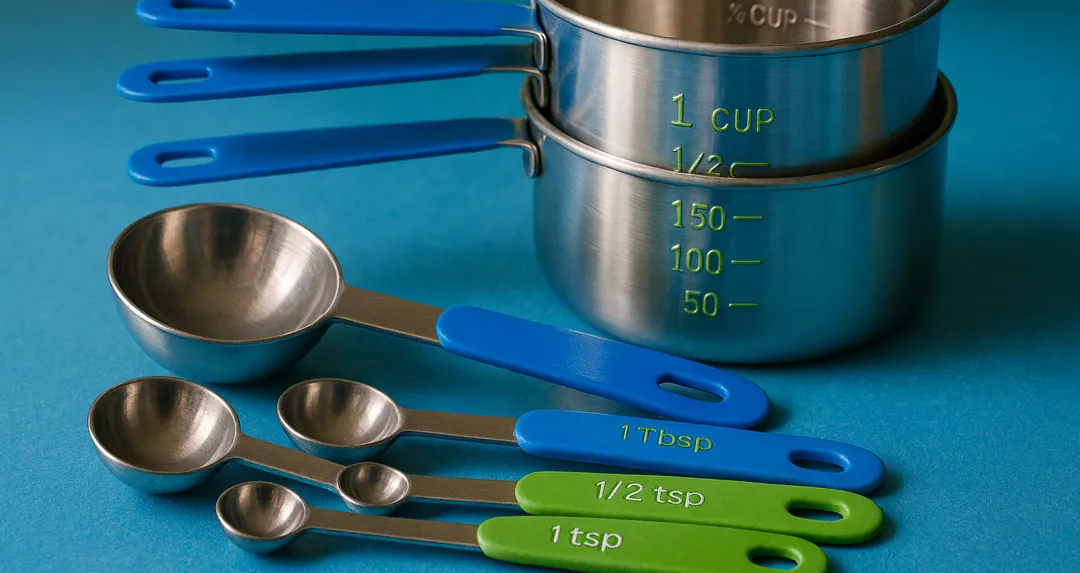
Guide to Kitchen Measurements
A Beginner's Guide to Kitchen Measurements
Understanding how to measure ingredients accurately is a fundamental skill in cooking. While it might seem daunting at first, a few simple rules and conversions will make you confident in the kitchen.
Part 1: Standard Kitchen Measurements
Most recipes use a handful of standard measurements. You'll need a set of measuring cups and spoons to get started.
Dry Measurements:
Used for ingredients like flour, sugar, and solid fats. Use a set of nested measuring cups (1,1/2,1/3,1/4 cup). Level off the top with a straight edge, like the back of a knife.
Liquid Measurements:
Used for ingredients like water, milk, and oil. Use a clear glass or plastic measuring cup with a spout and a handle. Place it on a flat surface and read the measurement at eye level.
Spoons:
Used for smaller quantities of both dry and liquid ingredients. A standard set includes:
1 tablespoon (tbsp)
1 teaspoon (tsp)
1/2 teaspoon (1/2 tsp)
1/4 teaspoon (1/4 tsp)
Tip: A "dash" or "pinch" is not a precise measurement. It's usually less than 1/8 of a teaspoon and is used for things like salt or spices to taste.
Part 2: Essential Cooking Conversions
Sometimes you need to convert between different units. This chart will be your best friend!
Spoons to Cups
Cups to Pints, Quarts, and Gallons
Cups
Pints
Quarts
Gallons
2 cups
1 pint
4 cups
2 pints
1 quart
16 cups
8 pints
4 quarts
1 gallon
A great way to remember this is using a simple visual:
1 Gallon = 4 Quarts = 8 Pints = 16 Cups.
Weight (Ounces to Pounds)
Ounces to Pounds
16 ounces (oz) = 1 pound (lb)
Important Note: Ounces in volume and ounces in weight are different! A fluid ounce measures volume, while a weight ounce measures mass. For baking, it's often more accurate to weigh your ingredients.
Part 3: Metric Conversions (International Standards)
Many recipes, especially those from outside the U.S., use the metric system. It's helpful to know these conversions.
Volume (Milliliters to Liters)
Milliliters
Liters
1000 milliliters (ml)
1 liter (L)
U.S. Customary to Metric Volume
U.S. Customary
Metric Equivalent (Approximate)
1 teaspoon (tsp)
5 ml
1 tablespoon (tbsp)
15 ml
1 fluid ounce (fl oz)
30 ml
1 cup
240 ml
1 pint
473 ml
1 quart
946 ml
1 gallon
3.8 L
U.S. Customary to Metric Weight
U.S. Customary
Metric Equivalent (Approximate)
1 ounce (oz)
28 grams (g)
1 pound (lb)
454 grams (g)
Tip: When a recipe calls for grams, it's best to use a kitchen scale for the most accurate results. This is especially true for baking, where precision is key.
Part 4: Temperature Conversions
Ovens in different regions use different temperature scales.
Fahrenheit to Celsius
The exact formula is C=(F−32)×95. Here are some common oven temperatures:
Fahrenheit (°F)
Celsius (°C) (Approximate)
250°F
120°C
300°F
150°C
325°F
165°C
350°F
175°C
375°F
190°C
400°F
200°C
425°F
220°C
450°F
230°C
Keep this guide handy in your kitchen, and you'll be able to tackle any recipe with confidence! Happy cooking!